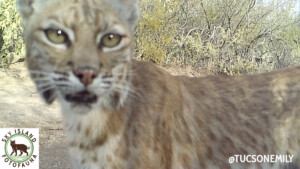
This good bobcat selfie is easy to find in my home FotoFauna photo library. It’s filed under my WASH camera master folder and June 2020/Bobcat subfolders.
Sky Island FotoFauna is our regional wildlife camera network powered by volunteers sharing monthly species checklists in Mexico and the U.S. To submit data, FotoFauna only requires one photo per species as a voucher to be shared with the monthly checklist for each camera.
Sounds simple, right?! Well, if you’re like me and have multiple cameras, a fistful of memory cards, and more bobcat photos than you know what to do with—it can be quite a task to simplify the volumes of data down into each final checklist.
There isn’t one best way to manage photos from wildlife cameras, so if you have a system that works – stick with it! If you feel a bit overwhelmed by photo management, here are some recommendations based on how I keep the monthly flow of photographs organized and ready to submit to FotoFauna from my home cameras.
Tip 1: Name your camera
The FotoFauna checklist now allows you to add your camera’s unique ID with the submission. This helps make sure that the camera name stamp on each image and the photo file structure you create on your computer matches up well with each checklist. The ID can be words or letters, just pick something simple and easy to remember. I recommend your initials and a number (e.g., EB_1), but place names or animals (e.g., WASH, BURROW, NESTCAM) make great names too. Once you’ve named your camera, please use this ID with every submission associated with the camera.
Tip 2: One camera = One folder
Keep all the photos or videos that come from the same camera in one place. Within this camera master folder, create subfolders for each month of the year and in each monthly folder, sort the photos by species. For example:
- THEWASH (camera ID)
- 2022 January (year and month)
- Javelina
- Cottontail
- Coyote
- Bobcat
Tip 3: Delete blank and redundant photos
For most wildlife-watchers using trail cameras as a hobby, only keeping the best photos or videos is a very reasonable practice. I discard all images that appear to have no animals in them. I keep multiple of the same species as long they are good images or representative of different behaviors. That means if I detect coyotes 12 times on a camera during a month, I’ll keep all of them unless a few are hard to decipher or blurry. For really common species that may be detected 100+ times a month, such as Gambel’s quail, I discard most of the images, keeping only a few for a record. I recommend keeping at least one image of every unique species detected each month so that you have an accurate record of all the species present.
Tip 4: Label your best photos with a searchable identifier in the file name
When I get a great photograph of an animal, I save the image with the word “good” in the title. For example, for a bobcat looking directly at the camera I might give it the file name of: “bobcat selfie good.” This enables me to search through my files for all good selfies or good bobcat images later, when needed. If you don’t have a more elaborate file tagging strategy, this simple naming convention can help you find your favorites in the future. For instance, when you are submitting your monthly FotoFauna checklist, you can find the best photo to submit by looking into the correct monthly folder and selecting one of the “good” photos labeled in each species folder:
- THEWASH (camera ID)
- 2022 January (year and month)
- Javelina
- Cottontail
- Coyote
- Bobcat:
- Bobcat 1
- Bobcat 2
- Bobcat 3
- Bobcat selfie good (select for checklist submission)
- Bobcat 4
Tip 5: Save your FotoFauna checklist photos in their own folder
Before I go online to submit my checklist, I copy the best photo (or screenshot from a video) of each species into a FotoFauna Checklist folder. This helps me compile the photos into a single folder to make uploading into the checklist portal more efficient and serves as a small collection of my best photos from that month as well:
- THEWASH (camera ID)
- 2022 January (year and month)
- Javelina
- Cottontail
- Coyote
- Bobcat
- FOTOFAUNA CHECKLIST PHOTOS (copy of best photos to submit)
Let us know if this helps! Also, learn more about how to recognize tricky to identify wildlife here.
